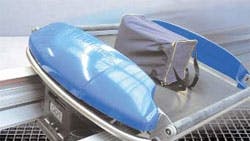Gearmotor Report: Gear reducers get a handle on baggage conveyors
We’ve all been there — waiting at the baggage claim carousel with the conveyor belt sitting idly and no airport personnel to be found. Only world weary passengers and whining children to exchange pitiful glances with. In post 9-11 America, with tightened airport security and bag matching initiatives at the forefront of homeland security, the waiting game seems destined to get worse. The question is, can the systems in place behind the scenes — past the car wash flaps hiding the “mystery area” your luggage hopefully spits out of — be optimized to run an airport in a timely, efficient, and cost-conscious manner?
The folks at SEW-Eurodrive, Lyman, S.C., say yes. The company offers several types of gear reducers, each with different qualities for various applications. For airport baggage handling, it recommends a direct-coupled helical reducer, either inline or right angle, because of the high efficiency. By selecting this type of gear reducer with integral motor, overall efficiency remains high, which helps contain operating costs.
Helical bevel reducers are available in two shaft types — solid and hollow. The hollow shaft version uses the machine shaft to support the gearmotor’s weight and needs only a torque arm for torque transmission, keeping installation costs down. A brand new hollow shaft solution called TorqLOC offers a keyless hollow shaft design with interchangeable tapered bushings. Because of the bushing design, no additional machining, turning, or milling is required. Cold rolled shaft stock can be used, again lowering installation costs. And, the tapered bushings make installation and removal a breeze.
Decentralization lowers costs, speeds start-up
In modern baggage handling systems, most motors are controlled by variable frequency drive (VFD). This, used in conjunction with field distributors, turns gearmotors into complete drive systems. Recently, Eurodrive also introduced a “decentralized” system that incorporates the reducer, motor, and controller into a compact package. With this approach, a module called a “field distributor” is used to route both motor power and communications between the motor and controller. This replaces the typical installation method of running separate cables from the motor control center to each motor, not to mention the individual communication and I/O wiring to each drive unit. The result? Lower cost, faster start-up, and beefed up baggage handling.
